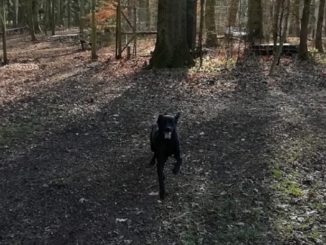Okay, I’ve skirted around the issue long enough, it’s time to tackle the complex subject of lead or forward allowance. To an experienced shooter, it is literally second nature, an unconscious calculation that is already factored in by the time you have shouldered your gun. For the less accomplished shot however, the whole thing can be a bit of a mystery, and something with countless influences that can only be discovered and mastered with practice. There are some things we have to consider before we get into it however, so thinking caps on.
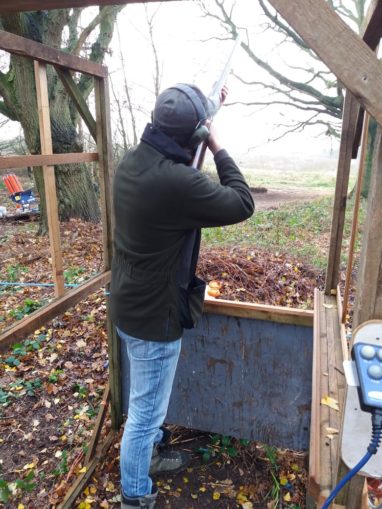
Firstly, your instructor will either consciously or through bias teach you to shoot using one of a handful of methods. Really, they are all achieving the same thing with minute differences, but they will all have their favourites, and can be a big bone of contention for some. The main method for beginners to get their first taste of forward allowance is through a technique called the ‘swing through’ method, and I find it the easiest way to teach the concept. Swing through requires you to mount the gun, and track the clay, before accelerating the swing of the barrels, overtaking (or pulling through), before squeezing the trigger at a predetermined ‘break point’. This method can be used to good effect on most targets, and feels the most natural for the average person. Other methods that are taught are ‘maintained lead’, which requires the barrels to remain in front of the target all the way through the mount and swing, before reaching the break point, and ‘pull away’, where the gun is shouldered with the barrels pointing at the target, before accelerating the swing through the break point. These latter methods are clay shooting techniques developed specifically for the sport, whereas the former was born out of live quarry shooting. As you can see, they are all basically the same, but can have wildly differing results depending on the type of target, swing speed, sight picture, footwork and gun mount. Phew, hope you are still with me.
Another thing to consider, and one that often catches people out is that you have to keep your barrels moving, even after you have pulled the trigger. Like follow through in a golf swing, it is an essential part of the process and will result in frustrating errors unless taken seriously. The reason for this is that when you pull the trigger, the shot takes a fraction of a second to travel down the barrel, and believe it or not, it can have enough of an effect to make you miss, and generally the more distant the target, the more exaggerated the effect. Also, a jerky ending with an abrupt stop to your swing will often cause your shot to end up at a different point from where you intend it. So always complete your swing. A consistent swing is just as important as gun mount and footwork.
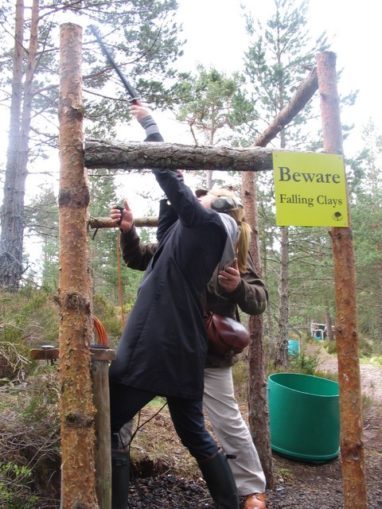
“File:Clay pigeon shooting – geograph.org.uk – 1322850.jpg” by Duncan Cain is licensed under CC BY-SA 2.0
Lead or forward allowance is the theoretical gap you as a shooter need to factor into your shot when aiming at a moving object. There are lots of determining factors such as the speed of the target and its distance from you, how the target is moving in relation to you, the speed you yourself move your gun, where and when you acquire your target and where you intend to shoot it and many other little things. The key to it all is, as always, consistency. If you mount your gun and move your feet in a smooth and predictable way, born from practice, you are 75% of the way there. I’m sure many of you know, clay pigeon shooting was used during WW2 to teach trainee pilots how to shoot down enemy planes. Once they had grasped the concept of lead on the ground, the reality that they needed to aim their 303s not where the target is, but where the target is going to be became obvious. If you shoot at a moving object, unless it is moving very slowly or it is very close, you will miss it. Some people will get this naturally, generally those with excellent hand/eye coordination, for others it takes some practice, but the good news is that it can be taught.
When out shooting, I don’t always get it right first time. Often I will miss my first one or two because the target has done exactly what it was designed to do, to deceive the eye and make you miss. As a beginner or improver, you won’t be facing targets like this, and hopefully your instructor will have a target in mind once he has evaluated your progress. Forward allowance doesn’t just mean the distance your shot needs to be in front of a clay pigeon. If the target is dropping, your line will need to be in front and below. If your target is rising, your shot will need to be in front and above. Always have a good look at the target before shouldering your gun, and make sure you understand how it is moving, pick your break point (the point in the clays path where you intend to hit it) and calculate what forward allowance you need to catch it. Faster clays and targets that are distant will require more, probably more than you think. Slower or close in targets will probably require less. It can be frustrating at first, but your brain soon works out the calculation, often without any conscious thought. If you are struggling, but are out with someone else or having a lesson, they will be able to point you in the direction of where you are going wrong, and the more experienced you are, the easier it is to work this out for yourself.
One last thing to consider about forward allowance is how you handle your gun. A short barrelled lightweight side by side is not ideal for clays, as you will swing through most targets too quickly and miss in front. A 10lb wildfowling piece will be slow and ponderous to mount, leaving you quickly tired and frustrated. The weight and balance of every gun is different, and is also a very individual taste. I prefer the majority of the weight to be between the hands, just forward of the action. A lot of competition shooters like the weight further back, and some like a heavier muzzle. There are various reasons for this, and a lot can depend on the particular discipline, but a general rule of thumb is that a well-balanced gun will give smoother more predictable swings, aiding greater consistency. The heavier the gun, the more composed the mount and swing, the lighter the gun, the faster and more inconsistent the swing. However, more weight means increased fatigue, so a heavy gun requires a higher level of physical fitness to handle properly, as you will tire sooner. Find a gun that suits your physical characteristics, fits you well and is suitable for the discipline you have chosen. Pick a cartridge that you find comfortable to shoot and which patterns well and consistently with your gun, and you will quickly begin to improve.
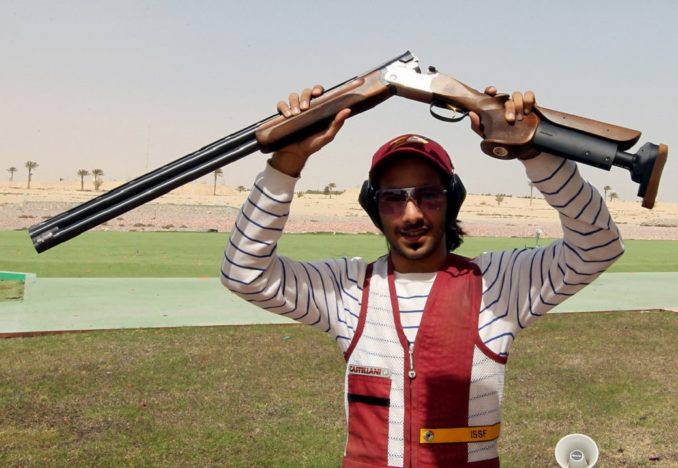
“Mohammed Ahmad Al Kuwari” by Doha Stadium Plus is licensed under CC BY 2.0
Away from forward allowance now, I’ve talked a lot about footwork, so I’ll explain a little about your stance and how to move when taking a shot. Ideally, when setting up for a shot, you should firstly face towards your targets break point, feet shoulder width apart, before moving whichever foot is opposite to your trigger hand forward half a pace, and place the majority of your bodyweight onto this leg, leaning ever so slightly forward, into the shot. This gives you a solid foundation to then rotate your body to your pick up point and mount your gun. When your target requires more than a small twist of your hips, you will need to move your feet to help you complete your shot. Failure to move your feet will result in you rolling your shoulder and tilting your gun, changing the relationship between your eye line and your swing, resulting in a miss. It is important that when moving a foot, you shift your balance to your back foot but try to remain leaning into the shot, planting your moving foot to point in the direction you intend to break the target and returning the weight distribution. You should ideally move your feet and swing your gun in one fluid motion, all the while keeping your eye on the target. This can seem an awkward and unnatural thing at first, and requires quite a lot of practice to perfect, but it pays dividends in the end.
Where you chose to ‘break’ or kill a target is entirely up to the shooter, but once chosen, the point should remain consistent. It is important not to ‘track’ the target with the gun shouldered for too long, as this will result in over thinking the shot and a miss. Most people will chose a break point somewhere in the middle of its flight path, but sometimes the course setter will force you into an early or late shot by clever use of the land or placed obstacles. You should aim to be as economical with your gun movement as possible, avoiding exaggerated or rushed swings, and keep things as smooth as possible, Instinct will tell you when the best time to pull the trigger is, but it is important to remember that every target is different, and what works for one may not be so useful on the next.
Something that many shooters struggle with, particularly into later life is eye dominance. Whether you realise it or not, one of your eyes is stronger than the other, and this can have a negative effect, depending on your handedness and which eye is your ‘master’. It is not uncommon for right handers to be left dominant, and vice versa, while there are those rare people who have what is known as central vision, whose dominant eye is only slightly stronger and experiences minimal effects. For people who are right/right and left/left, there is no problem, but for the unlucky, missing can become a frustrating occurrence. When you mount your gun, and bring your eye into line with the barrels, you should only be aware of the top of the rib (the top of the barrel section), and the target out in front. If you see the side of the barrel, you have an eye dominance issue, which will cause you to see a false picture of the target, making you miss either behind or in front depending on the type of target. There are many different methods for overcoming this, including shutting your opposite eye as you shoot, wearing glasses with a partially obscured lens, sighting aids like truglo which supposedly correct your vision by drawing the offending eye, and so on. For some people, it is such a problem that they will actually learn to shoot off their opposite shoulder, or heavily modify their gun with a crossover stock (meaning they shoulder on one side and sight on the other). Your vision is always changing, and you can develop master eye issues at any time, as I have in the last few years. It is the reason I gave up competitive shooting, and I am yet to find an effective solution, but I tend to keep both eyes open until I pull the trigger, ‘blinking’ as I take my shot. It isn’t perfect, but it works most of the time. Hopefully you will not share my problem.
Now we have reached the point where you want to move on to the next level. You have had the lessons, got your certificate, mastered the basics, chosen a discipline, have a nice smooth and consistent gun mount and foot work, understand the concept of forward allowance, and you have the best gun and cartridge combination you can afford. You want to test yourself against others in a competition, it’s only natural right? I love competitive shooting, it brings out the best in me and I always shoot better for real than when I practice. Not everyone feels the same way, so if competition isn’t for you, then who cares, just be happy doing what you want, and it’s not a necessary part of the sport.
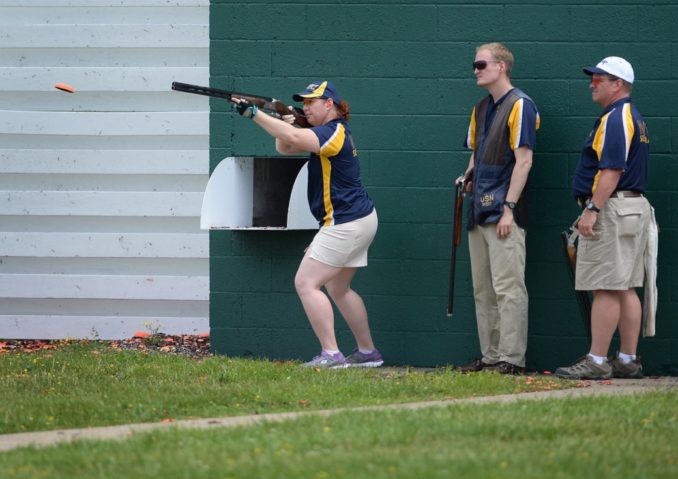
“160510-D-FW736-002” by DoD News Photos is licensed under CC BY 2.0
Most clubs will hold friendly competitions, usually on a monthly basis. They are usually shot as a squad (groups of four shooters starting at an allotted time, and may or may not have a scorer at each stand. These may have no prizes except perhaps the most important one of all – bragging rights. Some may keep a league table with a yearly prize on offer. Clubs that hold open non registered competitions which offer prize money will attract non club members, and some of them will be very good, but others will be cheats. I find these sorts of comps are best avoided as they are often very busy and the atmosphere can be intimidating for solo or inexperienced shooters.
The real fun starts when you decide to shoot in a registered competition, These will be run through a representative body, of which you will have to be a member (most likely the CPSA), be much more organised and will require a few things to qualify. Firstly, you must be a safe and competent shot, as these events will be refereed at every stand, and you will be ejected from the ground if you are deemed a danger to others. Secondly, you will need a classification, which will place you into a group based on your score. To be classified, you will need to shoot 100 targets in a registered event, and submit your score, You will then be given a classification, which is normally A B or C, and this will determine your level in future competitions, the use of handicaps and the distribution of prizes. For the CPSA, classifications are revisited every year, with a formula applied based on the average of every score you have submitted in the previous 12 months determining your classification for the next 12 months. It works better and is more realistic the longer you have been shooting. There are also sub divisions based on age, such as colts, juniors, veterans etc, and separate categories for male and female shooters (no other genders yet I’m afraid). Although I no longer shoot competitively, I was in the A class (top 10%) last time I entered.
Registered shoots often attract the top regional and national shooters, so can be a good place for a bit of star spotting. They are usually shot ‘squadded’, and if you are there alone, you will be put into a squad of similar level shooters. Rules will vary depending on the discipline you are shooting, so it is important to understand what is required of you before you enter. Competition will be fierce, so you may see some unsporting behaviour like crowding (where a squad looms over a shooter to try and put them off), referee intimidation and other nasty tricks. This is unacceptable behaviour, but some grounds turn a blind eye to it, lest they gain themselves a bad reputation and lose their status as an affiliate of the CPSA. I’ve seen famous shooters engaged in this before, and one or two have been suspended or barred from the CPSA as a result. Never question the ref, even if they are wrong and always be polite to them and your fellow shooters. Shoot your round and hand in your card at the end. Hang around to see if you qualify for a prize at the end, but you will most likely know straight away if you have done well or not. For Sporting, most registered shoots will be either over 100 or 125 targets, and you can expect a round to last at least two hours, but I’ve been out on the ground for over six in some cases. In the case of a tie, there are different methods for determining a winner, including a shoot off (an extra round where the first to miss loses, kind of like a penalty shoot-out), or count back/count forward, where the scorecard is examined, and the last person to miss loses, or the first person to miss loses. Expect scores of around 95/100 or 120/125 for the overall winner, with class B’s aiming for the early to mid-80s and class C’s scoring in the 70s. So you can see just how competitive these events are. Concentrate on your class, don’t try too hard and above all else, enjoy yourself.
If you get really good, there are much higher level competitions available to test your skill, all the way up to international level. You may be asked to represent your county or region if your abilities catch the eye of your local CPSA organisers, but this is where it starts getting expensive. Most will require qualification, although there are some open competitions even at this level, but really you will need sponsorship to have any chance, as the circuit is pretty much sewn up by professionals, and you will be going up against the very best in the world. I can’t remember the last time an amateur won a major competition, all I know is that I never came close.

“Peter Wilson” by FieldsportsChannel.tv is licensed under CC BY 2.0
There it is then. I’ve probably missed loads of things out, so please feel free to ask me any questions or point out any errors you see in the comments below. I hope this will encourage some of you to give it a go, it really is about as much fun as you can have with your clothes still on. Don’t be put off by the jargon, it may look daunting from the outside, but most people involved in the sport want new people to experience it, and then tell their friends so we become a bigger stronger group and more able to protect our interests. Like most things normal decent people enjoy, there is a nasty, bitter and twisted enemy out there, wanting only to destroy out of spite anything they don’t like. I’d hate to see shooting as a diverse and challenging sport go the way of so many other things our forebears enjoyed, because once it is gone, it’s never coming back. So what are you waiting for?
© Columba Palumbus 2021
The Goodnight Vienna Audio file


